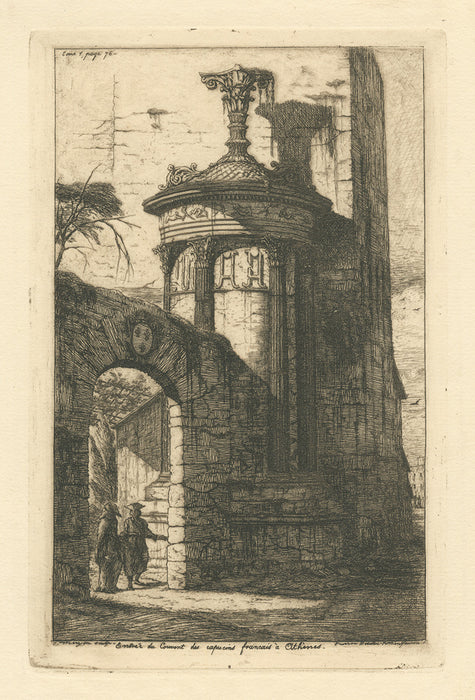Entrance to the Convent of the French Capuchins in Athens
Entrée du Couvent des Capucins Français à Athènes (original French title)
Etching printed on laid paper, 1854.
References: Delteil 61, Schneiderman 50. Third and final state, with the cursive letters. Scarce.
Supposedly published in Athènes au XVe, XVIe et XVIIe siècles, Paris, 1854 (1st volume, page 76). However, two copies of the book we were able to peruse did not contain this print (including the one in the possession of the Bibliothèque Nationale de France), and despite it being mentioned in the table of plates. It also seems all museum collections which have this etching, have it loose, not bound in the book. It may be that this etching was never actually included. It would explain its scarcity today.
This composition was created with the help of an etching by Jacques Philippe Le Bas (1707-1783), from 1758, which can be seen HERE, along with a photograph in the possession of Meryon at the time.
This is crisp and warm impression, in very good condition.
Count Léon de Laborde frames the historic context of this work as follows: “In 1669, the Capuchins purchased the Choragic Monument of Lysicrates in Athens, immediately east of the Acropolis. Father Simon acquired it as a citizen of Athens, and it is in this capacity that the commission of the historical monuments of France in 1845 invoked to restore a monument which still belonged to France. It had been preserved by France for nearly two centuries, and France wished to return in good condition to the newly reformed Greece. The convent of the Capuchins made this masterpiece of elegance a setting of simple purity, silent activity, and flowering shade. The royal coat of arms of France shone above its entrance. It was the noble sign of this pious European hostel.”
Les mots de Laborde, en Français: “Les Capucins achetèrent, en 1669, sur l'ancienne voie des Trépieds, le monument choragique de Lysicrate. Le père Simon en fit l'acquisition comme citoyen d'Athènes, et c'est ce titre que la commission des monuments historiques de France invoqua en 1845 pour restaurer un monument qui appartenait encore à la France, qu'elle avait conservé intact aux Beaux-Arts pendant près de deux siècles, et qu'elle voulait rendre en bon état à la Grèce régénérée. Le couvent des Capucins fit à ce chef-d'œuvre d'élégance un cadre de sa propreté simple, de son activité silencieuse, de ses ombrages fleuris. L'écusson royal de France brillait au-dessus de la porte d'entrée. C'était la noble enseigne de cette pieuse hôtellerie européenne.”
This print was a commission for the publication below. Meryon reminisces about the process of creating this etching: “Along with the print of Leroy, which I reduced to the requested size, I had a photograph of this elegant monument to aide me. My print is made very conscientiously, but too precisely and with lines still too harsh. In hindsight I realize I could easily have completed it, simply by better modulating certain parts with little additional work.”
Les mots de l’artiste, en Français: “Avec la pièce de Leroy, que j'ai réduite à la dimension demandée, j'avais pour m'aider à lire la structure première de ce gracieux monument, une photographie prise sur les lieux. Ma gravure est faite avec beaucoup de conscience, mais trop précise et dure encore d'exécution. J'ai vu aussi depuis qu'il m'eût été facile de la compléter, en modelant mieux certaines parties par l'addition de quelques travaux. (Meryon, Mes observations )”







